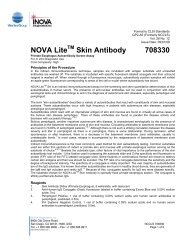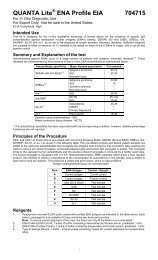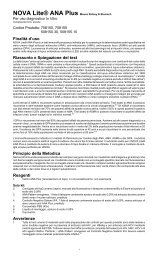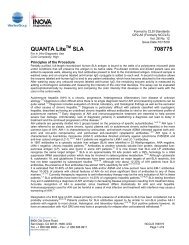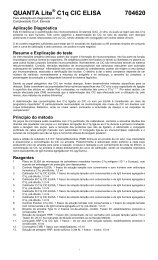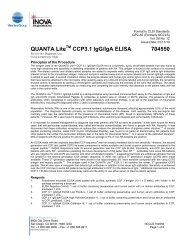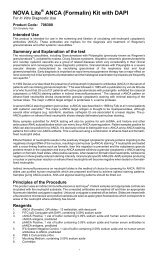NOVA LiteTM IgG F-Actin - inova
NOVA LiteTM IgG F-Actin - inova
NOVA LiteTM IgG F-Actin - inova
Create successful ePaper yourself
Turn your PDF publications into a flip-book with our unique Google optimized e-Paper software.
<strong>NOVA</strong> Lite® <strong>IgG</strong> F-<strong>Actin</strong> 708255For Export Only. Not for sale in the United States.For In Vitro Diagnostic UseCLIA Complexity: HighIntended UseThe <strong>NOVA</strong> Lite® <strong>IgG</strong> F-<strong>Actin</strong> kit is an indirect immunofluorescent assay (IFA) on rat intestine epithelialsubstrate for the screening and semi-quantitative determination of <strong>IgG</strong> anti-F-<strong>Actin</strong> antibodies in humanserum. The presence of <strong>IgG</strong> anti-F-<strong>Actin</strong> antibodies can be used in conjunction with clinical findings andother laboratory tests to aid in the diagnosis of autoimmune liver diseases such as autoimmune hepatitis(AIH) and primary biliary cirrhosis (PBC).Summary and Explanation of the test<strong>IgG</strong> anti-F-<strong>Actin</strong> autoantibodies are the main component of what have been called anti-smooth muscleantibodies (ASMA). 1-6 These antibodies are found in up to 80% of autoimmune hepatitis (AIH) patientsand up to 30% of patients with primary biliary cirrhosis 2,6 , but may also be found, usually at low titers, inindividuals without AIH. ASMA are heterogeneous and include antibodies to filamentous (F) and globular(G) forms of actin as well as non-actin components such as tubulin and intermediate filaments. 3,4,7Several autoantibodies are associated with AIH. However, <strong>IgG</strong> antibodies to F-<strong>Actin</strong> are the most specificautoantibody for AIH. 2,5While <strong>IgG</strong> F-<strong>Actin</strong> ELISA tests, such as the QUANTA Lite® <strong>Actin</strong> <strong>IgG</strong> ELISA, allow detection of <strong>IgG</strong> anti-F-<strong>Actin</strong> antibodies in an objective and quantifiable manner, some laboratories prefer IFA methodology toscreen for <strong>IgG</strong> anti-F-<strong>Actin</strong> antibodies or to confirm their presence when detected by the conventionalrodent kidney/stomach/liver (KSL) tissue sections. Differentiating anti-F-<strong>Actin</strong> from other antibodies tocomponents of smooth muscle is often difficult using conventional IFA substrates such as KSL tissuesections. 2,5 The identification of anti-F-actin is an important aid in the diagnosis of AIH. At the moment, a“gold standard” method for the discrimination of anti-F-actin from other reactivities is not available. 1,2Slides made with rat intestine epithelial cells prepared using proprietary growth and fixation methodsoffer a new substrate for detection of <strong>IgG</strong> anti-F-<strong>Actin</strong> antibodies by IFA. This substrate overcomessome of the limitations of other IFA procedures since the <strong>IgG</strong> anti-F-<strong>Actin</strong> pattern is distinct and otherantibodies that cause an interfering pattern on KSL slides do not interfere on the rat epithelial cellsubstrate.Principles of the ProcedureIn the indirect immunofluorescent technique, samples are incubated with the antigen substrate, andunbound antibodies are washed off. The substrate is then incubated with specific fluorescein labeledconjugate followed by a wash to remove the unbound reagent. When viewed through a fluorescencemicroscope, samples will exhibit an apple green fluorescence corresponding to areas whereautoantibody has bound. A sample is considered positive if specific staining is observed in the F-<strong>Actin</strong>fibers surrounding most cells in a hexagonal pattern, and sometimes observed in the fibers crossing overcells.Reagents1. F-<strong>Actin</strong> Slides; 6 wells/slide, with desiccant2. Anti-Human <strong>IgG</strong> Conjugate (Goat), 1 vial of fluorescein labeled in buffer containing Evans Blueand 0.09% sodium azide3. <strong>IgG</strong> F-<strong>Actin</strong> Positive Control, 1 vial of buffer containing 0.09% sodium azide and human serumantibodies to F-<strong>Actin</strong>, prediluted4. IFA System Negative Control, 1 vial of buffer containing 0.09% sodium azide and no humanserum antibodies to F-<strong>Actin</strong>, prediluted5. PBS Concentrate (40x), 2 vials6. Mounting Medium, 0.09% sodium azide, 1 vial7. CoverslipsWarnings1. All human source material used in the preparation of controls for this product has been tested andfound negative for antibody to HIV, HBsAg, and HCV by FDA cleared methods. No test method,however, can offer complete assurance that HIV, HBV, HCV or other infectious agents areabsent. Therefore, the <strong>IgG</strong> F-<strong>Actin</strong> Positive Control and IFA System Negative Control should behandled in the same manner as potentially infectious material. 82. Sodium Azide is used as a preservative. Sodium Azide is a poison and may be toxic if ingested orabsorbed through the skin or eyes. Sodium azide may react with lead or copper plumbing to formpotentially explosive metal azides. Flush sinks, if used for reagent disposal, with large volumes ofwater to prevent azide build-up.3. Use appropriate personal protective equipment while working with the reagents provided.4. Spilled reagents should be cleaned up immediately. Observe all federal, state and localenvironmental regulations when disposing of wastes.1
Precautions1. This product is for in vitro diagnostic use.2. Substitution of components other than those provided in this kit may lead to inconsistent results.3. Incomplete or inefficient washing of IFA wells may cause high background.4. Adaptation of this assay for use with automated sample processors and other liquid handlingdevices, in whole or in part, may yield differences in test results from those obtained using themanual procedure. It is the responsibility of each laboratory to validate that their automatedprocedure yields test results within acceptable limits.5. A variety of factors influence the assay performance. These include the starting temperature ofthe reagents, the strength of the microscope bulb used, the accuracy and reproducibility of thepipetting technique, the thoroughness of washing and the length of the incubation times duringthe assay. Careful attention to consistency is required to obtain accurate and reproducible results.6. Strict adherence to the protocol is recommended.Storage Conditions1. Store all the kit reagents at 2-8°C. Do not freeze. Reagents are stable until the expiration datewhen stored and handled as directed.2. Diluted PBS buffer is stable for 4 weeks at 2-8°C.Specimen CollectionThis procedure should be performed with a serum specimen. Addition of azide or other preservatives tothe test samples may adversely affect the results. Microbially contaminated, heat-treated, grosslyhemolyzed, or lipemic specimens containing visible particulates should not be used.Following collection, the serum should be separated from the clot. CLSI (NCCLS) Document H18-A3recommends the following storage conditions for samples: 1) Store samples at room temperature nolonger than 8 hours. 2) If the assay will not be completed within 8 hours, refrigerate the sample at 2-8°C.3) If the assay will not be completed within 48 hours, or for shipment of the sample, freeze at -20°C orlower. Frozen specimens must be mixed well after thawing and prior to testing.ProcedureMaterials provided5 6-well F-<strong>Actin</strong> Slides1 7mL FITC Anti-Human <strong>IgG</strong> Conjugate1 0.8mL <strong>IgG</strong> F-<strong>Actin</strong> Positive Control1 0.5mL IFA System Negative Control2 25mL PBS Concentrate (40x)1 7mL Mounting Medium1 Package of 10 CoverslipsAdditional materials required but not providedMicropipets to deliver 15-1000μL volumeDistilled or deionized waterSqueeze bottles or Pasteur pipetsMoist chamber1L container (for diluting PBS)Coplin jarFluorescent microscope with 495nm exciter and 515nm barrier filterMethodBefore you start1. Bring all reagents and samples to room temperature (20-26 o C).2. Dilute PBS Concentrate: IMPORTANT: Dilute the PBS Concentrate 1:40 by adding the contentsof the PBS Concentrate bottle to 975mL of distilled or deionized water and mix thoroughly. ThePBS buffer is used for diluting patient samples and as a wash buffer. The diluted buffer can bestored for up to 4 weeks at 2-8°C.3. Dilute Patient Samples:a. Initial Screening: Dilute patient samples 1:40 with diluted PBS buffer (i.e., add 50μL ofserum to 1.95mL of PBS buffer).b. Titration: Make serial 2-fold dilutions from the initial screening dilution for all positivesamples with diluted PBS buffer (i.e. 1:80, 1:160, 1:320... to endpoint).Assay procedure1. Prepare Substrate Slides: Allow the substrate slide to reach room temperature prior to removalfrom its pouch. Label it with pencil and place it in a suitable moist chamber. Add 1 drop (20-25μL)of the undiluted positive and the negative control to wells 1 and 2 respectively. Add 1 drop (20-25μL) of diluted patient sample to the remaining wells.2
2. Slide Incubation: Incubate the slide for 30 ± 5 minutes in a moist chamber (a dampened papertowel placed flat on the bottom of a closed plastic or glass container will maintain the properhumidity conditions). Do not allow the substrate to dry out during the assay procedure.3. Wash Slides: After incubation, use a plastic squeeze bottle or pipet to gently wash off the serumwith diluted PBS buffer. Orient the slide and stream of PBS buffer so as to minimize wash-over ofsamples between wells. Avoid directing the stream directly onto the wells to preventsubstrate damage. If desired, place the slides in a Coplin jar of diluted PBS buffer for up to 5minutes.4. Addition of Fluorescent Conjugate: Shake off the excess PBS buffer. Place the slide back inthe moist chamber and immediately cover each well with a drop of fluorescent conjugate.Incubate the slides for an additional 30 ± 5 minutes.5. Wash Slides: Repeat Step 3.6. Coverslip: Coverslip procedures vary from lab to lab; however, the following procedure isrecommended:a. Place a coverslip on a paper towel.b. Apply mounting medium in a continuous line to the bottom edge of the coverslip.c. Shake off the excess PBS buffer and touch the lower edge of the slide to the edge of thecoverslip. Gently lower the slide onto the coverslip in such a way that the mountingmedium flows to the top edge of the slide without air bubble formation or entrapment.Quality ControlThe <strong>IgG</strong> F-<strong>Actin</strong> Positive Control and IFA System Negative Control should be run on every slide toensure that all reagents and procedures perform properly. Additional suitable control sera may beprepared by aliquoting pooled human serum specimens and storing at < -70 o C. In order for the testresults to be considered valid, all of the criteria listed below must be met. If any of these are not met, thetest results should be considered invalid and the assay repeated.1. The undiluted <strong>IgG</strong> F-<strong>Actin</strong> Antibody Positive Control must be > 3+.2. The IFA System Negative Control must be negative.Interpretation of ResultsNegative Reaction: A sample is considered negative if specific staining as described below in thesection “Positive Reaction” is less than or equal to the IFA System Negative Control. Samples can exhibitvarious degrees of specific or background staining to other cellular components, but be negative for <strong>IgG</strong>anti- F-<strong>Actin</strong> antibodies.Positive Reaction: A sample is considered positive if specific staining at a greater intensity than the IFASystem Negative Control is observed in the F-<strong>Actin</strong> fibers surrounding most cells in a hexagonal pattern,and sometimes observed in the fibers crossing over cells.Determine the fluorescence grade or intensity using these criteria:4+ Brilliant apple green fluorescence3+ Bright apple green fluorescence2+ Clearly distinguishable positive fluorescence1+ Lowest specific fluorescence that enables the F-<strong>Actin</strong> staining to be clearly differentiatedfrom the background fluorescence.Pattern Interpretation: A variety of patterns of nuclear and/or cytoplasmic staining can be exhibiteddepending on the types and relative amounts of autoantibodies present in the sample. Only the patterndescribed above in the heading “positive reaction” should be considered positive for <strong>IgG</strong> anti-F-<strong>Actin</strong>antibodies. All other patterns should be considered negative.Limitations of the Procedure1. High-titered <strong>IgG</strong> anti-F-<strong>Actin</strong> pattern is suggestive of AIH but should not be considered diagnostic.The <strong>IgG</strong> anti-F-<strong>Actin</strong> result should be considered in combination with other laboratory results aswell as the overall clinical history of the patient.2. A variety of external factors influence the test sensitivity including the type of fluorescencemicroscope used, the bulb strength and age, the magnification used, the filter system and theobserver.3. If a band pass filter is used instead of a 515nm barrier filter, increased artifactual staining may beobserved.4. Only pencil should be used to label the slides. Use of any other writing material may causeartifactual staining.5. All coplin jars used for slide washing should be free from all dye residues. Use of coplin jarscontaining dye residue may cause artifactual staining.6. The assay performance characteristics have been established for serum, but not for plasma orother specimen types.3
Expected ValuesThe ability of the <strong>NOVA</strong> Lite® <strong>IgG</strong> F-<strong>Actin</strong> Kit to detect <strong>IgG</strong> F-<strong>Actin</strong> antibodies was evaluated bycomparison to commercially available QUANTA Lite® F-<strong>Actin</strong> <strong>IgG</strong> ELISA (I<strong>NOVA</strong> Diagnostics, Inc).ELISA results were determined to be positive if the patient sample was 20 units or greater and negative ifless than 20 units.Normal RangeFour hundred ninety three samples from normal blood donors were run using the <strong>NOVA</strong> Lite® <strong>IgG</strong>F-<strong>Actin</strong> kit. All but 4 of the 493 normal samples (99.2% specificity) were negative on <strong>NOVA</strong> Lite® <strong>IgG</strong>F-<strong>Actin</strong>.Comparison between <strong>NOVA</strong> Lite® <strong>IgG</strong> F-<strong>Actin</strong> IFA and QUANTA Lite®F-<strong>Actin</strong> <strong>IgG</strong> ELISATo determine the positive and negative percent agreement of the assays, 992 samples containingantibodies to a wide variety of antigens were tested with the <strong>NOVA</strong> Lite® <strong>IgG</strong> F-<strong>Actin</strong> IFA kit and theQUANTA Lite® <strong>Actin</strong> <strong>IgG</strong> ELISA. These samples included 493 normal blood donors, 60 patients withclinically defined diseases (rheumatoid arthritis, SLE, and scleroderma), 40 samples with definedantibodies (infectious diseases and autoantibodies) and 399 samples from patients suspected of havingliver disease.N=992QUANTA Lite® <strong>Actin</strong> <strong>IgG</strong>ELISAPositiveQUANTA Lite® <strong>Actin</strong> <strong>IgG</strong>ELISANegativeTotal<strong>NOVA</strong> Lite® <strong>IgG</strong> F-<strong>Actin</strong>Positive 269 21** 290<strong>NOVA</strong> Lite® <strong>IgG</strong> F-<strong>Actin</strong>Negative 69* 633 702Total 338 654 992Positive % agreement 269/338 (80%)Negative % agreement 633/654 (97%)Overall % agreement 902/992 (91%)*39 of the 69 are weak positive ELISA** 14 of the 21 were 1+ IFA (low reactivity)<strong>NOVA</strong> Lite, QUANTA Lite and I<strong>NOVA</strong> Diagnostics, Inc., are registered trademarks. Copyright 2011 All RightsReserved©4
References1. Chretien-Leprince P, Ballot E, Andre C, et al. Diagnostic value of anti-F-actin antibodies in aFrench multicenter study. Ann NY Acad Sci 1050: 266-273, 2005.2. Villalta D, Bizzaro N, Da Re M, et al. Diagnostic accuracy of four different immunological methodsfor the detection of anti-F-actin autoantibodies in type 1 autoimmune hepatitis and other liverrelated disorders. Autoimmunity 41: 105-110, 2008.3. Czaja A, Norman G: Autoantibodies in the diagnosis and management of liver disease. J ClinGastroenterol 37: 315-329, 2003.4. Toh BH. Smooth muscle autoantibodies and autoantigens. Clin exp Immunol 38: 621-628, 1979.5. Fusconi M, Cassani F, Zauli D, et al. Anti-actin antibodies: a new test for an old problem. Journalof Immunological Methods 130: 1-8, 1990.6. Granito A, Muratori L, Muratori P, et al. Antibodies to filamentous actin (F-actin) in type 1autoimmune hepatitis. J Clin Path 59: 280-284, 2006.7. Dighiero G, Lymberi P, Monot C. Sera with high levels of anti-smooth muscle and antimitochondrialantibodies frequently bind to cytoskeleton proteins. Clin exp Immunolol 82: 52-56,1990.8. Biosafety in Microbiological and Biomedical Laboratories. Centers for Disease Control/NationalInstitute of Health, 2007, Fifth Edition.Manufactured By:I<strong>NOVA</strong> Diagnostics, Inc.9900 Old Grove RoadSan Diego, CA 92131United States of AmericaTechnical Service (U.S. & Canada Only) : 877-829-4745Technical Service (Outside the U.S.) : 00+ 1 858-805-7950support@<strong>inova</strong>dx.comAuthorized Representative in the EU:Medical Technology Promedt Consulting GmbHAltenhofstrasse 80D-66386 St. Ingbert, GermanyTel.: +49-6894-581020Fax.: +49-6894-581021www.mt-procons.com628255ENG August 2011Revision 05




